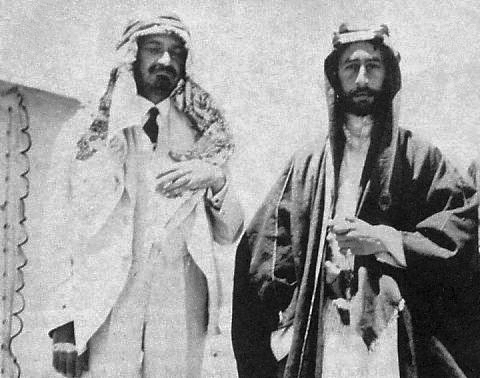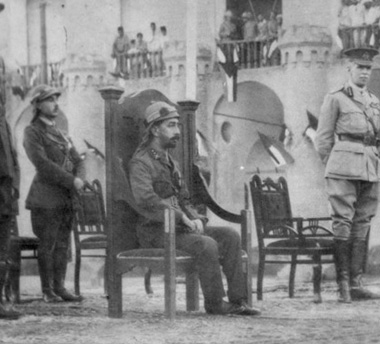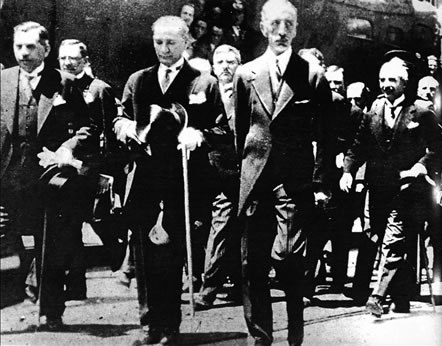<Back to Index>
- Economist Frédéric Passy, 1822
- Writer Sigrid Undset, 1882
- King of Iraq Faisal bin Hussein bin Ali al-Hashemi, 1883
PAGE SPONSOR
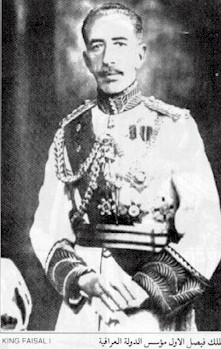
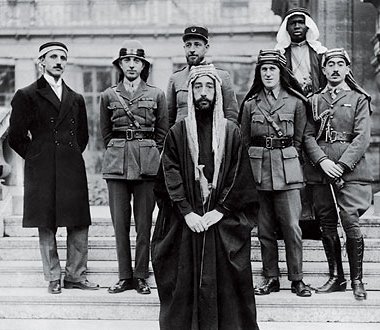
Faisal bin Hussein bin Ali al-Hashemi, (Arabic: فيصل بن حسين بن علي الهاشمي Fayṣal ibn Ḥusayn; 20 May 1883 – September 8, 1933) was for a short time King of the Arab Kingdom of Syria or Greater Syria in 1920, and was King of the Kingdom of Iraq (today Iraq) from 23 August 1921 to 1933. He was a member of the Hashemite dynasty, a descendant of the family of Muhammad.
Faisal encouraged overcoming cleavage between Sunni and Shiite to foster common loyalty and promote pan-Arabism in the goal of creating an Arab state that would include Iraq, Syria and the rest of the Fertile Crescent.
While in power, Faisal tried to diversify his administration by
including different ethnic and religious groups in offices. He faced
great challenges in achieving this because the region was under
European, specifically French and British, control and other Arab
leaders of the time were hostile to his ideas as they pursued their own
political aspirations for power. In addition, Faisal’s attempt at
pan-Arab nationalism inevitably isolated certain religious groups. Faisal was born in Ta'if (in present day Saudi Arabia) in 1883, the third son of Hussein bin Ali, Sharif of Mecca, the Grand Sharif of Mecca. He grew up in Istanbul and learned about leadership from his father. In 1913, he was elected as representative for the city of Jeddah for the Ottoman parliament. In 1916, on a mission to Istanbul, he visited Damascus twice. On one of these visits he received the Damascus Protocol, joined with the Al-Fatat group of Arab nationalists, and his father became king of Hejaz. On 23 October 1916 at Hamra in the Wadi Safra, the first encounter took place between Faisal and Captain T.E. Lawrence,
a relatively junior British intelligence officer from Cairo. Lawrence
already had a vision of an independent post-war Arabian state, and knew
it was essential to find precisely the right man to lead the Arab
forces to achieve this. With the help of Lawrence, Faisal sided with the British army and organised the Arab revolt against the Ottoman Empire, helping to end the Caliphate. After a long siege he conquered Medina, defeating the defense organized by Fakhri Pasha. Some of Faisal's critics considered fighting alongside Christians as a betrayal of Islam; this motivated Iqbal to write against him. Though Faisal was a descendant of the Islamic prophet Muhammad, Arab nationalism and independence, not religion, was his main motivation. Faisal also worked with the Allies during World War I in their conquest of Greater Syria and the capture of Damascus, where he became part of a new Arab government in 1918. In 1919 Faisal led the Arab delegation to the Paris Peace Conference and, with the support of the knowledgeable and influential Gertrude Bell, argued for the establishment of independent Arab emirates for the area previously covered by the Ottoman Empire. His role in the Arab Revolt was described by Lawrence in Seven Pillars of Wisdom, although the accuracy of that book has been criticized by historians. On 3 January 1919, Faisal and Dr. Chaim Weizmann, President of the World Zionist Organization signed the Faisal – Weizmann Agreement for Arab - Jewish cooperation, in which Faisal conditionally accepted the Balfour Declaration based
on the fulfillment of British wartime promises of development of a
Jewish homeland in Palestine and on which subject he made the following
statement: "We
Arabs... look with the deepest sympathy on the Zionist movement. Our
deputation here in Paris is fully acquainted with the proposals
submitted yesterday by the Zionist Organisation to the Peace
Conference, and we regard them as moderate and proper. We will do our
best, in so far as we are concerned, to help them through; we will wish
the Jews a most hearty welcome home... I look forward, and my people
with me look forward, to a future in which we will help you and you
will help us, so that the countries in which we are mutually interested
may once again take their places in the community of the civilised
peoples of the world." These promises were not immediately fulfilled, in some cases not until after the de-facto establishment of the Jewish state but once Arab states were granted autonomy from the European powers years after the Faisal - Weizmann Agreement, and
these new Arab nations were recognized by the Europeans and the U.N.,
Weizmann argued that since the fulfillment was kept eventually, the
agreement of development of a Jewish homeland in Palestine still held. In the end this hoped for partnership was not carried out by either side. On 7 March 1920, Faisal was proclaimed King of the Arab Kingdom of Syria (Greater Syria) by the Syrian National Congress government of Hashim al-Atassi. In April 1920, the San Remo conference gave France the mandate for Syria, which led to the Franco - Syrian War. In the Battle of Maysalun on 24 July 1920, the French were victorious and Faisal was expelled from Syria. He went to live in the United Kingdom in August of that year. In March 1921, at the Cairo Conference, the British decided that Faisal was a good candidate for ruling the British Mandate of Iraq.
But, in 1921, few people living in Iraq even knew who Faisal was or had
ever heard his name. Though he was not popular there was a lack of
organized opposition so he could remain ruler and establish power. The British government, mandate holders in Iraq, were concerned at the unrest in the colony. They decided to step back from direct administration and create a monarchy to head Iraq while they maintained the mandate. Following a plebiscite showing
96% in favour, which was not really accurate, but created by a British
council of ministers who wanted to put Faisal in power, Faisal agreed
to become king. In August 1921 he was made king of Iraq. He
encouraged an influx of Syrian exiles and office seekers to cultivate
better Iraqi - Syrian relations. In order to improve education in the
country Faisal employed doctors and teachers and in the civil service
appointed Sati' al-Husri,
the ex-Minister of Education in Damascus, as his director of the
Ministry of Education. This influx resulted in much native resentment
towards Syrians and Lebanese in Iraq. Faisal also developed desert motor routes from Baghdad to Damascus, and Baghdad to Amman. This led to a great interest in the Mosul oilfield and eventually to his plan to build an oil pipeline to a Mediterranean port, which would help Iraq economically.
This also led to an increase in Iraq’s desire for more influence in the
Arab East. During his reign, Faisal made great effort to build Iraq’s
army into a powerful force. He attempted to impose universal military service in order to achieve this, but this failed. Some see this as part of his plan to advance his pan-Arab agenda. In 1925, after the Syrian Druze uprising, the French government began consulting Faisal on Syrian matters. He advised the French to restore Hashemite power in Damascus. The French consulted Faisal because they were inspired by his success as an imposed leader in Iraq. Faisal saw the Anglo-Iraqi Treaty of
1930 as an obstacle to his pan-Arab agenda, although it provided Iraq
with a degree of political independence. He wanted to make sure that
the treaty had a built-in end date because the treaty further divided
Syria and Iraq, the former which was under French control, and the
latter under British rule. This prevented unity between two major Arab
regions, which were important in Faisal’s pan-Arab agenda. Ironically, Arab nationalists in
Iraq had a positive reception to the treaty because they saw this as
progress, which seemed better than the Arab situation in Syria and Palestine. In 1932, the British mandate ended and Faisal was instrumental in making his country nominally independent. On 3 October, the Kingdom of Iraq joined the League of Nations. Also in 1932, Shah Faisal dreamt that he was being addressed by Hudhayfah ibn al-Yaman, who said "O King! Remove Jabir ibn Abdullah Ansari and
me from the bank of river Tigris and bury us at some safe place because
my grave is already filled with water while Jabir's grave is collecting
water slowly." That year, a large number of Muslims and non-Muslims,
along with the King, Grand Mufti, Prime Minister, and Prince Farooq of
Egypt were there for the opening of graves of both trusted companions
of Muhammad. Both of the bodies were said to be fresh and intact while
their open eyes were said to issue forth such divine light that the
spectators' eyes were dazzled. Furthermore, their coffins, clothes, and
kaffan were also intact and at first glance, it appeared as if they
were alive. The two bodies were then taken away and buried afresh near
the grave of Salman al-Farsi, in Salman Park, which is 30 miles from
Baghdad. In August 1933, incidents like the Simele massacre caused tension between the United Kingdom and Iraq. Prime Minister Ramsay McDonald ordered High Commissioner Francis Humphrys to Iraq immediately upon hearing of the killing of Assyrian Christians.
The British government demanded that Faisal stay in Baghdad to punish
the guilty — whether Christian or Muslim. In response, Faisal cabled to
the Iraqi Legation in London: "Although everything is normal now in
Iraq, and in spite of my broken health, I shall await the arrival of
Sir Francis Humphrys in Bagdad, but there is no reason for further
anxiety. Inform the British Government of the contents of my telegram." In
July 1933, right before his death, Faisal went to London where he
expressed his alarm at the current situation of Arabs that resulted from the Arab - Jewish conflict and
the increased Jewish immigration to Palestine, as the Arab political,
social, and economic situation was declining. He asked the British to
limit Jewish migration and land sales, for fear that “otherwise in the
near future the Arabs would either be squeezed out of Palestine or
reduced to economic and social servitude.” He died on September 8, 1933, when he had a heart attack while he was staying in Bern, Switzerland. He was succeeded on the throne by his oldest son Ghazi. A square is named in his honour at the end of Haifa Street, Baghdad,
where an equestrian statue of him stands. The statue was knocked down
following the overthrow of the monarchy in 1958, but later restored.
